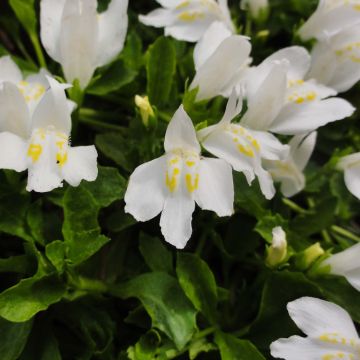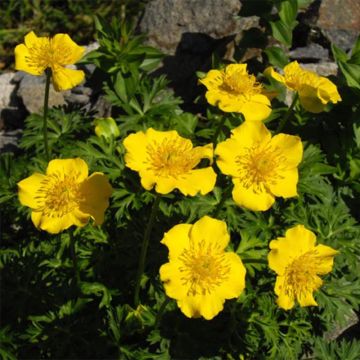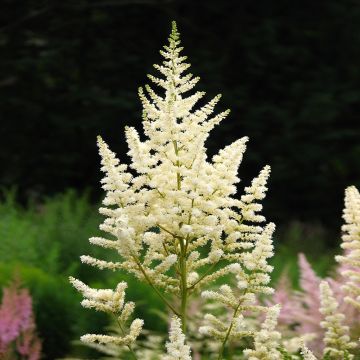

Cyperus prolifer - Papyrus nain


Cyperus prolifer - Papyrus nain


Cyperus prolifer - Papyrus nain
Cyperus prolifer
Cyperus prolifer
Papyrus
This plant carries a 12 months recovery warranty
More information
We guarantee the quality of our plants for a full growing cycle, and will replace at our expense any plant that fails to recover under normal climatic and planting conditions.
From €5.90 for pickup delivery and €6.90 for home delivery
Express home delivery from €8.90.
Delivery to Corse prohibited: UE law prohibits the import of this plant from mainland France to Corse as part of the fight against Xylella fastidiosa. Please accept our sincere apologies.
More information
Does this plant fit my garden?
Set up your Plantfit profile →
Description
Cyperus prolifer or Dwarf Papyrus is an elegant perennial of wet soils and mild climates. It is generally similar to its cousin the Nile Papyrus with its original silhouette formed by long stiff stems topped with bracts gathered in an umbrella, but it has a more modest growth, among the smallest of the Cyperus. Its appearance is stiffer, but this species has a greater ability to withstand the often dry atmosphere of our interiors. Outdoor cultivation is only possible in the mildest regions, unaffected by severe frosts. In this case, it is possible to cultivate it partly submerged in a pond or on shores. Versatile, it also accepts container cultivation, in a constantly moist substrate.
Cyperus prolifer belongs to the family of Cyperaceae. It is native to the marshy areas from Somalia to South Africa, from Madagascar to the Mascarene Islands. It needs constantly moist soil. This plant is now cultivated in all temperate regions for its ornamental qualities, especially as a houseplant. It is frost-sensitive from -5°C (23°F). Semi-aquatic, it develops many leafless, stiff stems from its rhizomes, reaching 50cm (20in) in height under our climates. The stump spreads laterally over about 30cm (12in), but without a theoretical limit. Each stem bears at its end a relatively narrow crown, composed of stiff, relatively thin, ray-like bracts, of a bright green colour. In spring, a small inflorescence composed of tiny pale yellow flowers appears in the centre of each crown, turning brown in summer, when ripe. These flowers give rise to seeds that are dispersed by the wind. Cyperus prolifer reproduces through the dissemination of its seeds and vegetatively, through lateral growth of its rhizomes. Unlike true Nile Papyrus, it is easily propagated by immersing its heads in water.
Cyperus prolifer, a beautiful riverside plant in very mild climates, also makes a very attractive terrace or indoor plant, very easy to grow as long as the soil in which it is planted remains always moist. It works wonders in a small above-ground pond arranged on the terrace, for example. It appeals to enthusiasts of luxuriant plants because of its bamboo-like silhouette and exotic appearance. Perfect as a standalone plant, its association in open ground or in a pot with Cannas with purple or green foliage, Nandina, Dierama, or Persicaria is always successful. In a pond, immerse it between 0 and 20cm (1 and 8in) deep.
Properties: Cyperus plants are air-purifying for our confined atmospheres.
Report an error about the product description
Cyperus prolifer in pictures


Flowering
Foliage
Plant habit
Botanical data
Cyperus
prolifer
Cyperaceae
Papyrus
Madagascar
Other Cyperus
Planting and care
Plant Cyperus prolifer in a very sunny location, in a mixture of potting soil and garden soil kept constantly moist, for example by placing a deep saucer filled with water under the pot. From April to the end of September, apply liquid fertilizer twice a month. Cut back dry stems in November. Overwinter your Cyperus frost-free, but in a very sunny, minimally heated room. If you grow Cyperus indoors, it is sometimes useful to mist its foliage from time to time, due to the often too dry atmosphere in our interiors. During the warm season, from April-May to October, your pot of Papyrus can be displayed on the terrace or balcony, in full sun. Exposure to harsh sunlight should be done gradually, to avoid burning the foliage after winter. Divide your Papyrus when it becomes too large, and give some as gifts to your friends and neighbors. Keep an eye out for the appearance of whiteflies or red spider mites indoors. These parasites thrive in dry and warm atmospheres.
If you submerge it in a pond, it should be between 0 and 20cm (1 and 8in) deep.
In the ground, if the temperatures do not drop too low in winter, the submerged stump can survive and the plant will regenerate in the following spring. In regions far from the seaside, it is essential to grow Papyrus in a pot.
Propagation by division of stumps from spring to summer, or, also very easily, by propagation from the ends of stems, turned upside down, and immersed in water.
Planting period
Intended location
Care
This item has not been reviewed yet - be the first to leave a review about it.
Aquatic plants
Haven't found what you were looking for?
Hardiness is the lowest winter temperature a plant can endure without suffering serious damage or even dying. However, hardiness is affected by location (a sheltered area, such as a patio), protection (winter cover) and soil type (hardiness is improved by well-drained soil).

Photo Sharing Terms & Conditions
In order to encourage gardeners to interact and share their experiences, Promesse de fleurs offers various media enabling content to be uploaded onto its Site - in particular via the ‘Photo sharing’ module.
The User agrees to refrain from:
- Posting any content that is illegal, prejudicial, insulting, racist, inciteful to hatred, revisionist, contrary to public decency, that infringes on privacy or on the privacy rights of third parties, in particular the publicity rights of persons and goods, intellectual property rights, or the right to privacy.
- Submitting content on behalf of a third party;
- Impersonate the identity of a third party and/or publish any personal information about a third party;
In general, the User undertakes to refrain from any unethical behaviour.
All Content (in particular text, comments, files, images, photos, videos, creative works, etc.), which may be subject to property or intellectual property rights, image or other private rights, shall remain the property of the User, subject to the limited rights granted by the terms of the licence granted by Promesse de fleurs as stated below. Users are at liberty to publish or not to publish such Content on the Site, notably via the ‘Photo Sharing’ facility, and accept that this Content shall be made public and freely accessible, notably on the Internet.
Users further acknowledge, undertake to have ,and guarantee that they hold all necessary rights and permissions to publish such material on the Site, in particular with regard to the legislation in force pertaining to any privacy, property, intellectual property, image, or contractual rights, or rights of any other nature. By publishing such Content on the Site, Users acknowledge accepting full liability as publishers of the Content within the meaning of the law, and grant Promesse de fleurs, free of charge, an inclusive, worldwide licence for the said Content for the entire duration of its publication, including all reproduction, representation, up/downloading, displaying, performing, transmission, and storage rights.
Users also grant permission for their name to be linked to the Content and accept that this link may not always be made available.
By engaging in posting material, Users consent to their Content becoming automatically accessible on the Internet, in particular on other sites and/or blogs and/or web pages of the Promesse de fleurs site, including in particular social pages and the Promesse de fleurs catalogue.
Users may secure the removal of entrusted content free of charge by issuing a simple request via our contact form.
The flowering period indicated on our website applies to countries and regions located in USDA zone 8 (France, the United Kingdom, Ireland, the Netherlands, etc.)
It will vary according to where you live:
- In zones 9 to 10 (Italy, Spain, Greece, etc.), flowering will occur about 2 to 4 weeks earlier.
- In zones 6 to 7 (Germany, Poland, Slovenia, and lower mountainous regions), flowering will be delayed by 2 to 3 weeks.
- In zone 5 (Central Europe, Scandinavia), blooming will be delayed by 3 to 5 weeks.
In temperate climates, pruning of spring-flowering shrubs (forsythia, spireas, etc.) should be done just after flowering.
Pruning of summer-flowering shrubs (Indian Lilac, Perovskia, etc.) can be done in winter or spring.
In cold regions as well as with frost-sensitive plants, avoid pruning too early when severe frosts may still occur.
The planting period indicated on our website applies to countries and regions located in USDA zone 8 (France, United Kingdom, Ireland, Netherlands).
It will vary according to where you live:
- In Mediterranean zones (Marseille, Madrid, Milan, etc.), autumn and winter are the best planting periods.
- In continental zones (Strasbourg, Munich, Vienna, etc.), delay planting by 2 to 3 weeks in spring and bring it forward by 2 to 4 weeks in autumn.
- In mountainous regions (the Alps, Pyrenees, Carpathians, etc.), it is best to plant in late spring (May-June) or late summer (August-September).
The harvesting period indicated on our website applies to countries and regions in USDA zone 8 (France, England, Ireland, the Netherlands).
In colder areas (Scandinavia, Poland, Austria...) fruit and vegetable harvests are likely to be delayed by 3-4 weeks.
In warmer areas (Italy, Spain, Greece, etc.), harvesting will probably take place earlier, depending on weather conditions.
The sowing periods indicated on our website apply to countries and regions within USDA Zone 8 (France, UK, Ireland, Netherlands).
In colder areas (Scandinavia, Poland, Austria...), delay any outdoor sowing by 3-4 weeks, or sow under glass.
In warmer climes (Italy, Spain, Greece, etc.), bring outdoor sowing forward by a few weeks.


















































